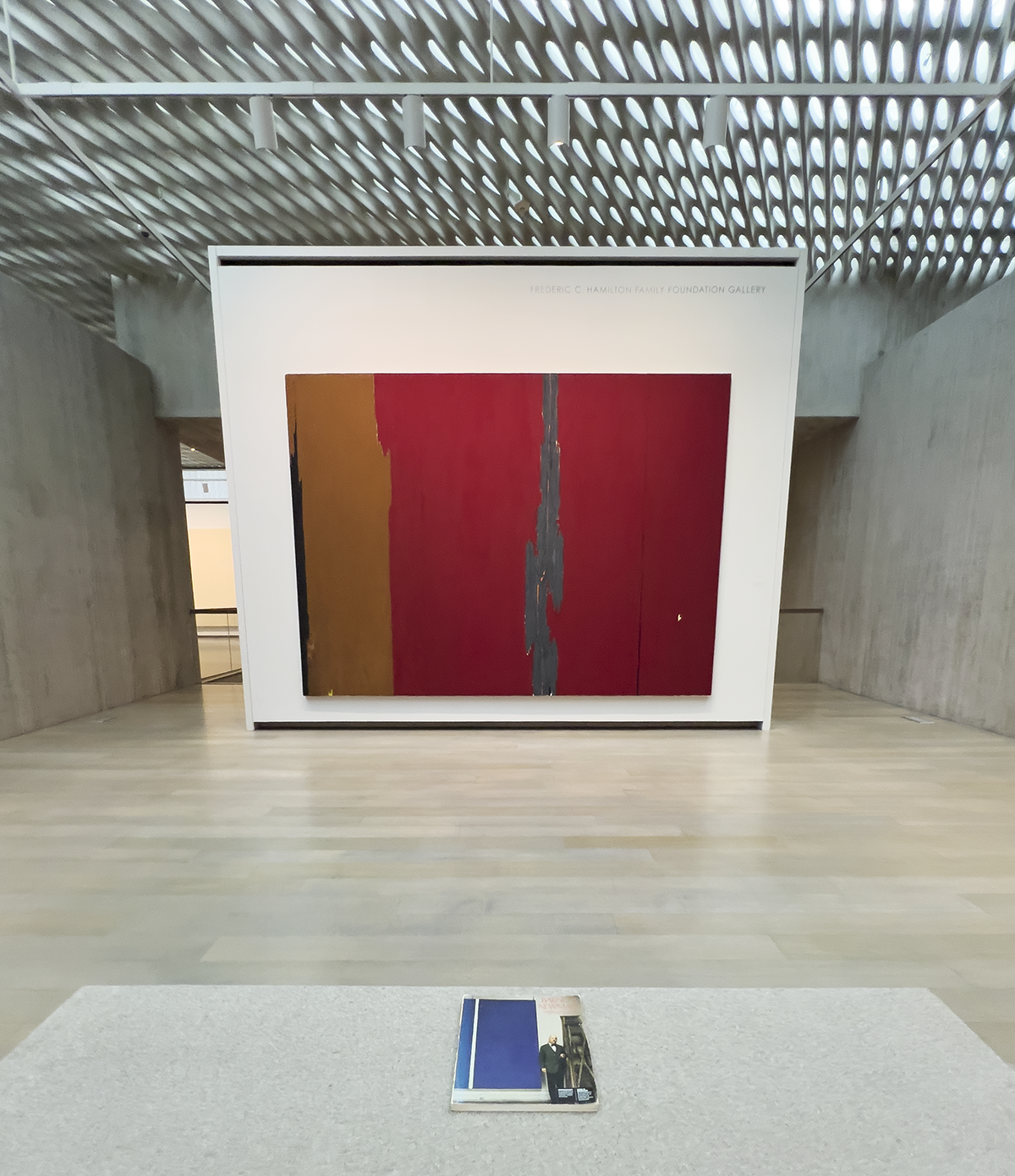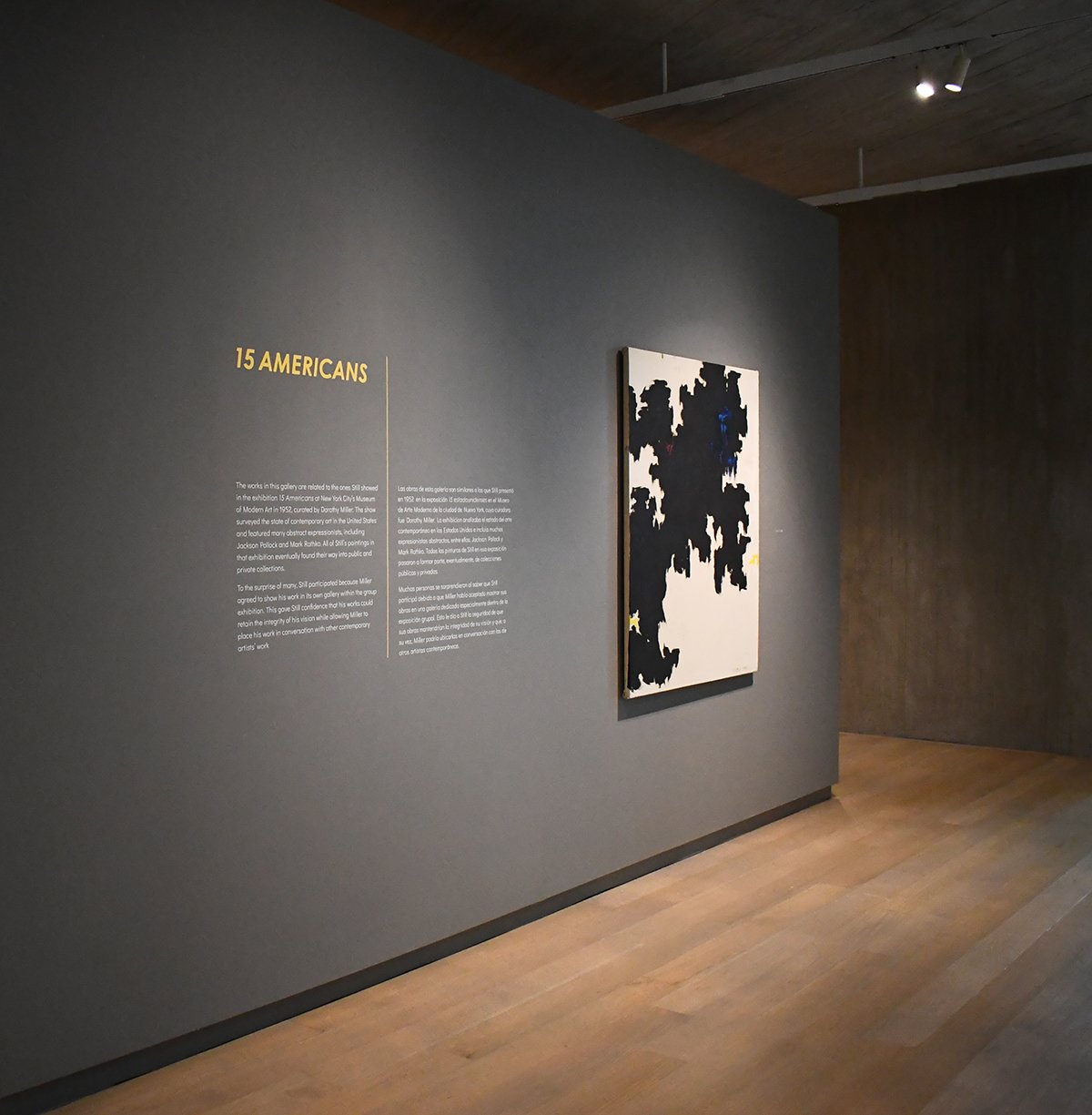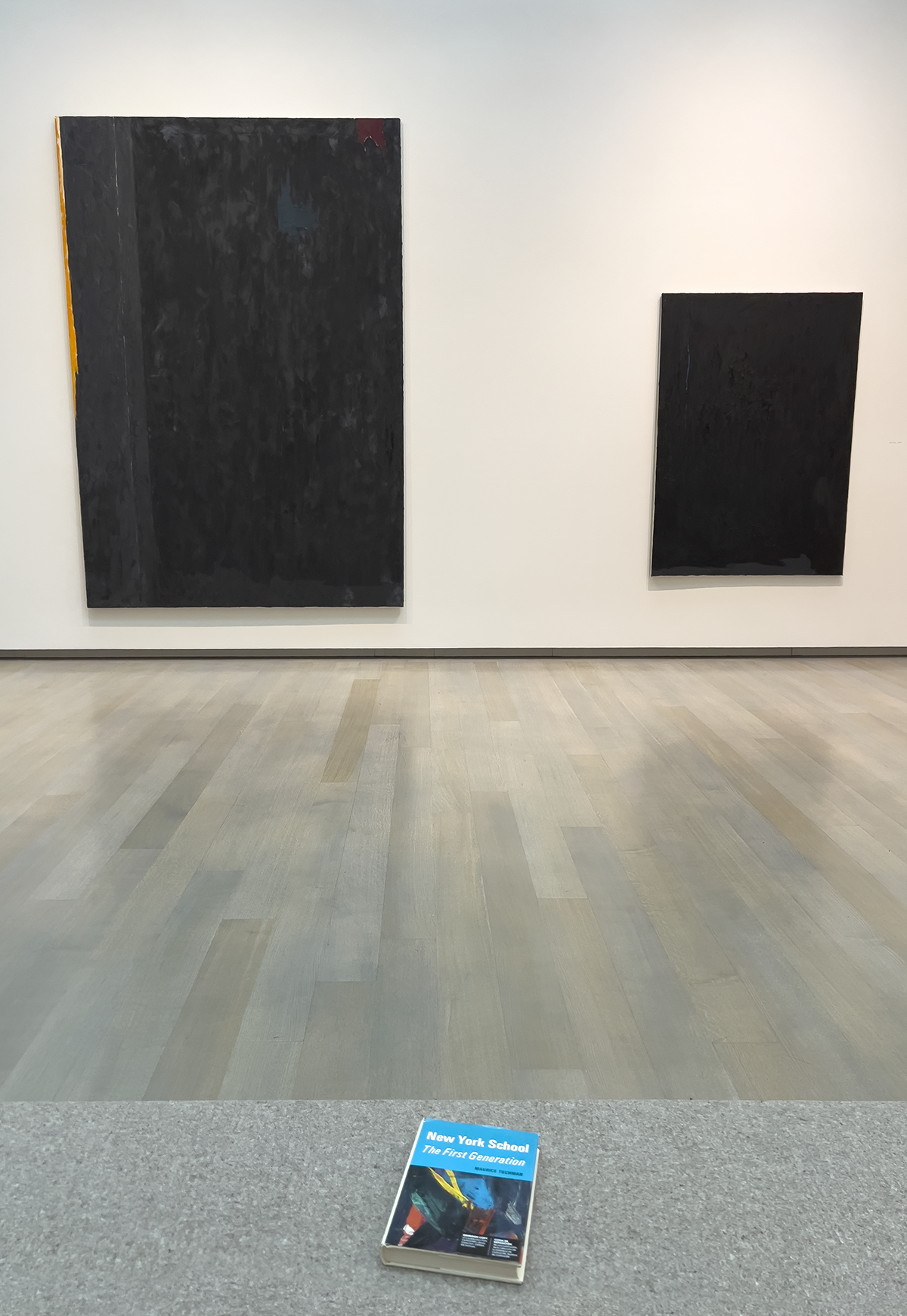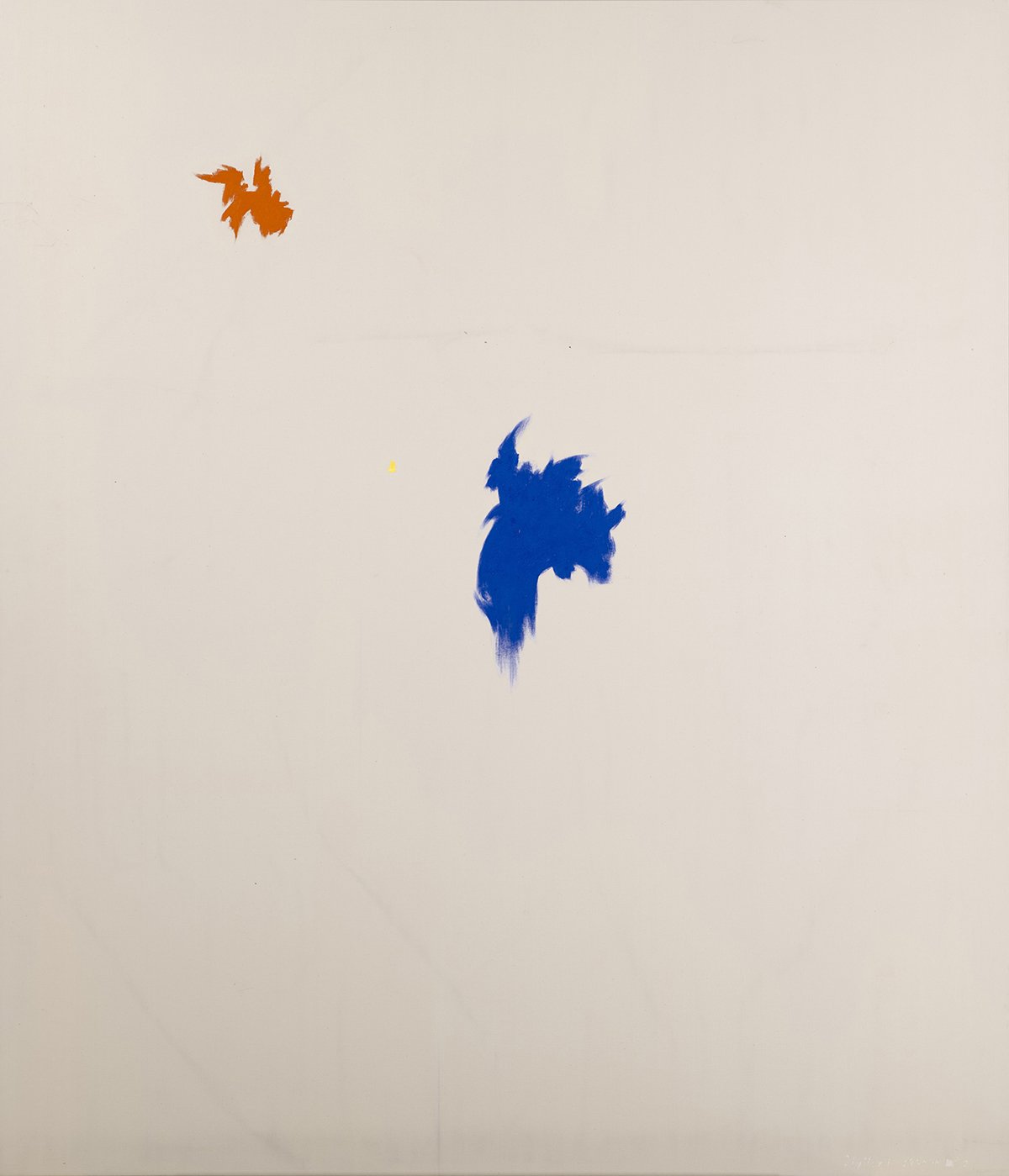Dialogue and Defiance
Dialogue and Defiance: Clyfford Still and the Abstract Expressionists
Clyfford Still Museum
1250 Bannock Street, Denver, CO 80204
May 10, 2024–January 12, 2025
Admission: Colorado resident adults: $10, Colorado seniors: $8, Non-resident adults: $15, Non-resident seniors: $10, College students, teachers, and military: $6, Members and 17 and under: free
Review by José Antonio Arellano
Guest curator Valerie Hellstein had her work cut out for her with the exhibition Dialogue and Defiance. The exhibition tries to qualify Clyfford Still’s notorious “defiance” of the artworld by emphasizing the “dialogue” between him and his contemporaries—those who came to be called the Abstract Expressionists. Still, though, would no more have admitted to having been in dialogue with his peers than he would have wanted an art critic to review his paintings.
An installation view of the exhibition Dialogue and Defiance: Clyfford Still and the Abstract Expressionists at the Clyfford Still Museum. Image courtesy of the Clyfford Still Museum.
If the “artworld” is a game of publicity, Still refused to play. [1] In 1951, at the height of Abstract Expressionism’s growing popularity, he withdrew his paintings from the Betty Parsons Gallery. Parsons played a crucial role in promoting the work of Still, Barnett Newman, Jackson Pollock, and Mark Rothko, offering each painter a major solo exhibition.
Yet Still stopped exhibiting due to, in his words, the “particular issue of exposing my works [to] a network of associations and evaluations entirely at variance with the implications of my act in painting…” [2] In his estimation, such comparisons led to an inaccurate assessment of his accomplishments.
Thomas B. Hess’s book Barnett Newman on display in the exhibition Dialogue and Defiance: Clyfford Still and the Abstract Expressionists at the Clyfford Still Museum. Image by José Antonio Arellano.
Dialogue and Defiance, though, insists on comparing Still to his contemporaries. Although Still refused to exhibit his paintings on the same walls as his peers, the exhibition includes books containing pictures of their work. Viewers can thus make visual connections linking Still’s efforts with those of Newman and Rothko.
An image of the cover of the 15 Americans exhibition catalog. Image courtesy of the Clyfford Still Archives.
A year after withdrawing from the Betty Parsons Gallery, Still agreed to be included in the MoMA exhibition Fifteen Americans, curated by another indispensable advocate of emerging artists, Dorothy C. Miller. Miller’s “Americans” exhibitions began in the 1940s and typically included a set of artists selected by Miller for their significance in contemporary art.
Clyfford Still’s PH-111, 1948, oil on canvas, 54.375 x 45 inches, on display in the Dialogue and Defiance exhibition. Image courtesy of the Clyfford Still Museum.
Still’s inclusion in 1952, along with Pollock and Rothko, provided viewers an opportunity to witness the trends changing the New York art scene. But, in a letter republished in that exhibition’s catalog, Still rejects the expectation that “the artist [...] perpetuate the values of his contemporaries.” [3] Tellingly, Miller exhibited Still’s paintings in their own room.
Clyfford Still, PH-16, 1950/52, oil on canvas, 69.625 x 62.5 inches. Image by José Antonio Arellano.
I quote Still often to highlight the extent to which defiance, not dialogue, constituted his métier. Even in his mid-twenties, Still claimed to have studied enough art history to conclude that “very few” of the artists proclaimed as “masters” “merited the admiration they received.” [4] The few that did deserve the recognition had “achieved true worth,” Still argued, “after they had defied the means and mores.” [5]
The Dialogue and Defiance exhibition could thus be justifiably charged with attempting to blunt the “blade” (Still’s word) of his self-described “identity,” upon which he imagined “impaling” (his word again) “those symbols of obeisance to—or illustration of—vested social structures, from antiquity through Cubism and Surrealism to my then immediate contemporaries.” [6] Still understood his paintings as producing the very foundation upon which he could exist as “the individual” resisting the “collectivist denominators of his time.” [7]
A book about the Abstract Expressionists called New York School, the First Generation: Paintings of the 1940s and 1950s by Malcolm Tuckman, on display in the exhibition Dialogue and Defiance: Clyfford Still and the Abstract Expressionists at the Clyfford Still Museum. Image by José Antonio Arellano.
It is ironic, however, how much Still’s statements express a common postwar ethos. In his very resistance to his era, Still exemplifies it, evincing a concern that other relatively privileged Americans were articulating after World War II. Sociological studies and best-selling books from the 1950s tracked a changing “American character” resulting from the gradual shift in the economy. [8] The rise of corporations increased the prominence of white-collar jobs that, writers worried, could lead to a loss of a creative individuality that resisted conformity. [9] The proverbial American individualism was seemingly at stake in this transition to more bureaucratic and clerical work.
An installation view of the exhibition Dialogue and Defiance: Clyfford Still and the Abstract Expressionists. Image courtesy of the Clyfford Still Museum.
This was the “age” of what William Deresiewicz calls a “culture boom,” during which institutions of higher education developed at a seemingly exponential rate, in part to accommodate recipients of the GI Bill. [10] The country “built museums, theaters, concert halls, opera companies, and ballet troupes… Foundations, residencies, organizations, councils—an entire bureaucratic apparatus arose to support the creation of art… Art, in short, was institutionalized.” [11]
The concept of “the artist” had entered a paradigm of professionalization that looked starkly different from its more “Bohemian” past. [12] The artist-as-professional could earn a living through the associations now available with the rise of what Still himself called the “Culture State.” [13]
Clyfford Still, PH-385, 1949, oil on canvas, 105.5 x 81 inches. Clyfford Still Museum, Denver, CO. © City and County of Denver - ARS, NY.
The “smothering omnipresence” of this “contemporary Moloch,” Still argued, appeared to subsume any “place, ideologically or practically” not in its sway. [14] Still served as the head of the graduate painting program at the California School of Fine Arts (now San Francisco Art Institute) from 1946 to 1950, during a time of considerable growth in MFA programs throughout the country.
Even as he helped develop the program’s curriculum, Still ultimately refused to compromise his painting for the sake of a day job that was at odds with what he considered his real work. He quit every teaching position he held and ultimately moved to rural Maryland, where he painted alone in a barn.
But he was not alone in identifying the tension between the freedom of creative expression and the potential conformity produced by the institutions enabling artists’ lives. [15] While some viewed the art of the time as a symptom of corporate “groupthink,” others saw art itself as a potential solution. [16] With secure employment, which just might allow a degree of leisure, Americans might use their free time to create and appreciate art. [17]
A view of the title wall in the exhibition Dialogue and Defiance: Clyfford Still and the Abstract Expressionists. Image courtesy of the Clyfford Still Museum.
In a country deeply rooted in the liberal tradition, it is not surprising to encounter the valorization of what the philosopher Charles Taylor calls the “monological ideal”—the belief that one’s authentic identity is developed within oneself, outside of social influence. [18] Liberal philosophers have long debated whether a life could be considered one’s own if it was unduly influenced by others. A question arises as to whether one “romantically” discovers one’s essential core within oneself or “existentially” creates an identity in dialogue with others. [19]
The figure of The Artist is attractive to both the romantic and existentialist models, for who do we consider more expressive of her inner essence than The Artist? And who can be in a better position to create an identity?
Clyfford Still, PH-1071, 1951, oil on canvas, 117.75 x 106 inches. Image by José Antonio Arellano.
Even as “the solitary artist” appears to offer a paradigmatic example of a monological life, writes Taylor, the artist’s “work itself is addressed to a future audience, perhaps still to be created by the work. The very form of a work of art shows its character as addressed.” [20]
With Taylor’s point in mind, we can more fully consider the “dialogue” of this exhibition’s title. Even as Still painted alone in his barn, he was not creating himself or his paintings ex nihilo. He insisted on sustaining the life of an artist in the terms available in his era, which today appear as increasingly diminishing possibilities. Still’s paradigm of the artist, “professional” or otherwise, today seems practically impossible. [21]
Clyfford Still’s PH-146 on display in the Dialogue and Defiance exhibition. Image courtesy of the Clyfford Still Museum.
Insofar as Still’s paintings are speaking to an “us” that they bring into being—when you and I stand before a Still canvas that produces a “we” that otherwise would not exist—what are these paintings saying? They do not communicate the way language does, of course. [22] Nor do they offer a visual narrative attached to the realism Still had explored earlier in his career. Instead, these paintings produce the conditions through which a deeply moving aesthetic experience can take place.
As my banal description of an “aesthetic experience” demonstrates, I have difficulty describing the effect the paintings have on me. These are not the frenetic actions within Pollock’s canvases, nor are they the absorbing depths of Rothko’s, which appear formulaic in light of Still. The canvases induce calm, but not simply calm. They imply something like an attunement, a sense of ease that resonates in my very mitochondria.
Clyfford Still, PH-146, 1950, oil on canvas, 107.375 x 92.25 inches. Image courtesy of the Clyfford Still Museum, Denver, CO. © City and County of Denver - ARS, NY.
When I have trouble finding the words to describe what I feel, my mind turns to poetry. You can read the first stanza of Wallace Stevens’s poem “The Poems of Our Climate” to get an approximation of the mood inside the subtly designed space of the Clyfford Still Museum. [23] The museum filters the stark Colorado sunlight into its gallery spaces, sympathetically illuminating the displayed work. If you stare at a painting such as PH-146, you might experience a similar sensation as encountering a crystal bowl that is placed just so, containing clear water and flowers arranged perfectly, as if perfection was waiting to be formally embodied. If you really look at PH-146, you will see the slightest dab of yellow paint between the orange and blue, a trace of the painter’s presence.
On the left: Clyfford Still, PH-1078, 1951, oil on canvas, 113 x 158 inches; on the right: Clyfford Still, PH-812, 1951, oil on canvas, 115 x 104 inches. Image courtesy of the Clyfford Still Museum.
Through Still’s composition, each of his canvases appears aware of its edges. Some, such as PH-1078, more concretely highlight these edges with the addition of a contrasting color along a border. Yet, even as the paintings acknowledge their edges, they suggest that the depicted space is not confined within a singular canvas. I get the sense that only through the totality of his life’s work can we begin to intuit that other, what should we call it, a space? a spiritual realm? that beckoned Still.
Clyfford Still, PH-369, 1951, oil on canvas, 80 x 71.5 inches. Image courtesy of the Clyfford Still Museum, Denver, CO. © City and County of Denver - ARS, NY.
Looking into a painting such as PH-369, I see the results of Still revealing, bit by bit, an otherwise invisible space that only competent, patient labor can bring forth.
This exhibition displays painting at its most ambitious calling, making visible the very dignity of spirit that we are called upon to honor in each other. I do not have the language to describe who or what exactly is doing this calling. If I did, these paintings would be beside the point. Witnessing the nobility of this work, I stand upright and follow Still’s vertical gestures.
An installation view of the exhibition Dialogue and Defiance. Image courtesy of the Clyfford Still Museum.
Still did not have me in mind when he made this gift of 825 paintings and over 1,500 works on paper. But the stance I am invited to take before this work is one of gratitude for the singular soul that dared to paint when the world wanted him to advertise and sell. By refusing to subject his paintings to the market, by gifting hundreds of canvases and decades of labor, Still insisted that his work be understood on its own terms. These paintings are not commodities with which we can do whatever we please.
Clyfford Still, PH-121, 1947, oil on canvas, 45 x 39.625 inches. Image by José Antonio Arellano.
This work tells us today that another world is possible if we learn to value the dignity of labor in which we can see a self externalized, not merely reflected as in a funhouse mirror. Such a gift affirms the abiding conviction that art makes dignity visible as nothing else can.
José Antonio Arellano (he/his) is an Associate Professor of English and Fine Arts at the United States Air Force Academy. He holds a Ph.D. in English Language and Literature from the University of Chicago. He is currently working on two manuscripts titled Race Class: Reading Mexican American Literature in the Era of Neoliberalism, 1981-1984 and Life in Search of Form: 20th Century Mexican American Literature and the Problem of Art.
[1] For a definition of the “artworld” that includes the role of institutions such as museums, galleries, and professions, including art critics, gallerists, and curators, see Arthur C. Danto, "The Artworld," The Journal of Philosophy 61.19, 1964, pp. 571-584.
[2] Clyfford Still, Letter to Betty Parsons, September 21, 1951, reprinted in Clyfford Still Museum: Inaugural Publication (Clyfford Still Museum, 2011), 32.
[3] Clyfford Still, Letter to Dorothy Miller, February 5, 1952, reprinted in Dorothy C. Miller, 15 Americans. Museum of Modern Art, 1952.
[4] Clyfford Still, “A Statement by the Artist,” Clyfford Still: Thirty-Three Paintings in the Albright-Knox Art Gallery (Buffalo Fine Arts Academy, 1966), 16.
[5] Ibid.
[6] Ibid., 17.
[7] Ibid., 18.
[8] See David Riesman, Nathan Glazer, Reuel Denney, The Lonely Crowd: A Study of the Changing American Character (Yale University Press, 1950).
[9] See C. Wright Mills, White Collar: The American Middle Classes (Oxford University Press, 1951).
[10] William Deresiewicz, The Death of the Artist: How Creators Are Struggling to Survive in the Age of Billionaires and Big Tech (Holt Paperbacks, 2022), 242-243.
[11] Ibid., 243.
[12] Ibid., 246.
[13] “A Statement by the Artist,” 18.
[14] Ibid.
[15] For an account of how the tension between academic freedom and academic conformity motivated postwar literature produced in creative writing programs, see Mark McGurl, The Program Era: Postwar Fiction and the Rise of Creative Writing (Harvard University Press, 2009).
[16] For an account of midcentury literature as exemplifying the conformism of bureaucratic life, see William H. Whyte, “Love that System,” The Organization Man (Simon and Schuster, 1956).
[17] See Riesman et al., “Enforced Privatization: Obstacles to Autonomy in Play,” The Lonely Crowd: A Study of the Changing American Character (Yale University Press, 1950).
[18] Charles Taylor “The Politics of Recognition,” Multiculturalism: Examining the Politics of Recognition (Princeton University Press, 1994), 33.
[19] Anthony Appiah, The Ethics of Identity (Princeton University Press, 2005), 17.
[20] Taylor, 34.
[21] Our artistic paradigm is situated entirely within the market; the “Artist” has become the content “Producer.” Deresiewicz, 270-273.
[22] “[O]nce when asked if he was concerned with communication,” writes Harry Cooper, “he sneered that that was ‘what the comic strip does.’” Harry Cooper, "Still Against Himself: Clyfford Still in Retrospect." Artforum, vol. 50, no. 3, Nov. 2011. Artforum, www.artforum.com/print/201109/still-against-himself-clyfford-still-in-retrospect-29222.
[23] The first lines of the poem are these: “Clear water in a brilliant bowl, / Pink and white carnations. The light / In the room more like a snowy air, / Reflecting snow. A newly-fallen snow…” Wallace Stevens, "The Poems of Our Climate." The Norton Anthology of Poetry, edited by Margaret Ferguson, et al., (W. W. Norton & Company, 2018), 1330.























